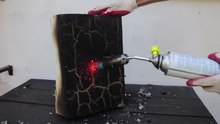Polyisocyanurates
Polyisocyanurates (abbreviation PIR ) are plastics related to polyurethanes (PUR) , which are used specifically for thermal insulation . The proportion of diphenylmethane diisocyanate (MDI) is higher than that of PUR. Furthermore, a polyester polyol is used as the reactant instead of a polyether polyol . Isocyanuric acid occurs as a structural element in PIR .
Manufacture and properties
The reaction of MDI and polyol takes place at higher temperatures than in the production of polyurethane. At these elevated temperatures, the MDI also reacts with itself to form strong chains of isocyanurate . This cross-linking is stronger than normal bonds in polyurethane and therefore harder to break. PIR is chemically and thermally more stable than PUR, degradation begins above 400 ° C. PIR has a typical MDI / polyol ratio of 2: 1 to 5: 1, with PUR the ratio is 1: 1. The stiffness of the material increases non-linearly with the ratio.
use
PIR is mainly produced as foam and used in the form of rigid foam panels as a strong material for thermal insulation of buildings. Its thermal conductivity has a typical value of 0.023 W / (m K), which is one of the lowest among classic insulation materials. The panels are laminated with aluminum foil on both sides during production .
Fire hazard
PIR insulation boards are self-extinguishing or charring in the prescribed fire tests, but combustible at high ambient temperatures, e.g. B. by heat build-up, as occurred in the fire at Grenfell Tower . The fire safety is higher than with PUR insulation boards. In Germany, due to its flammability, PIR insulation may only be installed in buildings whose floors can be reached with a turntable ladder .
Norms
- EN 13165 Thermal insulation products for buildings - Factory made rigid polyurethane foam (PU) products - Specification .
Individual evidence
- ↑ PUR and PIR: What is the difference? , June 26, 2006
- ↑ Patent EP1924356 : Process for the production of rigid polyisocyanurate foam. Registered on August 21, 2006 , published on January 20, 2010 , applicant: BASF SE, inventors: Pit Lehmann, Peter Malotki, Gianpaolo Tomasi, Gillian Peden, Rainer Hensiek.
literature
- Entry on polyisocyanurates. In: Römpp Online . Georg Thieme Verlag, accessed on June 7, 2014.


